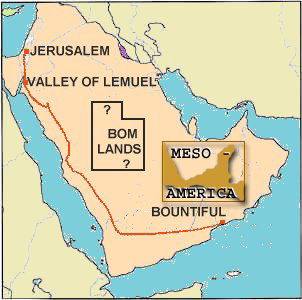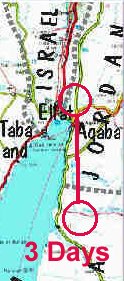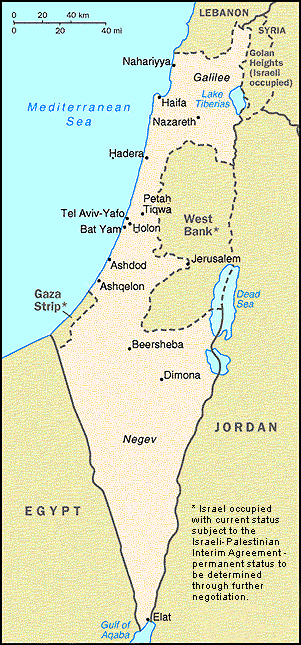

Often Lehi is portrayed as a traveling merchant with knowledge of the roads and the ways of the Merchants. I don't think so. First of all Nephi points out explicitly that Lehi has lived all the days of his life in the Land of Jerusalem (1 Nephi 1:4). Lehi’s land was the ‘land of his inheritance,’ indicating that it had been the land of his father before him. Lehi’s parentage is never given other than that Lehi is a descendant of Joseph through the line of Manasseh and is a likely relative of Laban as Laban's Brass Plates contain both their genealogies. But one might consider that Lehi was either the eldest son or of a family of small size because his land and property of inheritance seemed to place him amongst the wealthy families of the city. Further one needs to begin to consider that the City of Jerusalem proper was within walls in which was the inner residents and buildings of the city including the palace of the King and the site of the temple. If one is to consider that Lehi was a man of ‘land,’ one would need to consider that his pastures and fields where outside the city walls, though Lehi would of course consider himself as a member of the nearest primary city, Jerusalem to where his ‘land’ laid. Much like Boaz, the ancestor of King David of the Book of Ruth, who lived in Bethlehem, Lehi was a citizen of the Land of Jerusalem, just as Joseph and the Savior where.
Another point of Lehi not being a man of travels and acquainted with the skills of navigating the land is that the Lord provides for Lehi's short coming. That is, the Lord knows Lehi has never been out of the Land of Jerusalem before in his life. Traveling the trade route, perhaps with a caravan, until he reaches the borders of the Red Sea, and then traveling along the borders of the Red Sea south for three days is one thing. Lehi would not likely get lost in doing this as the route was not very challenging. But to navigate across the entire Sadie Arabia peninsula to its southeastern coast line is quite another for an unskilled traveler. Thus the Lord would provide Lehi with the Liahona to guide him to his next destination.
Boaz, like Lehi, was a man of the harvest. He had servants over his fields and he was the lord of the manor so to speak. Lehi was wealthy having gold and silver and may precious things. And he had lands as did Boaz. Lehi's acquaintance with the merchants was in the market places of Jerusalem where he would sell his products. In the days past, before industrialization, the plantation owners where the men of position and of wealth. Look at the south of the colonies of America. The Lord needed such a man as Lehi. One of the primary responsibilities of Lehi was to gather seeds of all kinds and to bring them for their use in the Land of Promise. What would a merchant of wares know of seeds. What would a man such as Boaz and as Lehi know of seeds? Like the southern plantation owner, Lehi was learned and well educated, he was not only a man of the fields, but he would have been a man of the city, as that was where he would transact his business in the market places of the city. This I believe portrays more what I consider Lehi to have been like. Consider him a Jefferson or a Washington with estates and lands. A wealthy land owner who prospered because of his own diligence in the business marketplace. He was just the man for the job the Lord had in store for him.
 Often it is quickly calculated and stated that Lehi’s permanant encampment
in the Valley of Lemuel lay only
three days travel from Jerusalem. This is not what the record states. The
reader must first consider two verses to appropriately understand. Verse
5 says that Lehi came down by the boarders near the shore of the Red Sea. That
was a 200 mile journey from Jerusalem, which at 20 miles a day would take a
couple of weeks. Then Lehi traveled in the wilderness in those boarders
which are nearer the Red
Often it is quickly calculated and stated that Lehi’s permanant encampment
in the Valley of Lemuel lay only
three days travel from Jerusalem. This is not what the record states. The
reader must first consider two verses to appropriately understand. Verse
5 says that Lehi came down by the boarders near the shore of the Red Sea. That
was a 200 mile journey from Jerusalem, which at 20 miles a day would take a
couple of weeks. Then Lehi traveled in the wilderness in those boarders
which are nearer the Red
 Sea. Verse 6 merely clarifies that it was three days traveled in that
wilderness in the borders of the Red Sea. Thus Lehi’s journey from Jerusalem
is traveled in two phases. The first phase is from Jerusalem to the
boarders near the shore of the Red Sea. This part of the journey is most
likely the portion of the journey which was traveled on known merchant roads
and paths. Perhaps Lehi's little party had joined with a merchant with whom
Lehi was acquainted and trusted. It wasn’t until Lehi’s party reached near
the Red Sea that Lehi veered off the ‘beaten’ track and ventured into the wilderness where no established roads or paths were to be found. How many days it took from Jerusalem to reach the Red Sea just isn’t supplied as part of Nephi’s record. Further verse 5 stipulates that the party
consisted of Lehi, Nephi’s mother Sariah, and the three elder brothers, Laman,
Lemuel, and Sam. Six people in all. It is speculation to include others as
part of this original party. Some include younger sisters which may well be
as Hebrew writings often leave out women in their descriptions. Others include
servants in Lehi's party. I will address this later, but let me ask, 'With
whom did Lehi leave in trust his land and property that months later if not
years, Nephi and his brothers where able to recover the property to trade it
for the Brass Plates of Laban?
Sea. Verse 6 merely clarifies that it was three days traveled in that
wilderness in the borders of the Red Sea. Thus Lehi’s journey from Jerusalem
is traveled in two phases. The first phase is from Jerusalem to the
boarders near the shore of the Red Sea. This part of the journey is most
likely the portion of the journey which was traveled on known merchant roads
and paths. Perhaps Lehi's little party had joined with a merchant with whom
Lehi was acquainted and trusted. It wasn’t until Lehi’s party reached near
the Red Sea that Lehi veered off the ‘beaten’ track and ventured into the wilderness where no established roads or paths were to be found. How many days it took from Jerusalem to reach the Red Sea just isn’t supplied as part of Nephi’s record. Further verse 5 stipulates that the party
consisted of Lehi, Nephi’s mother Sariah, and the three elder brothers, Laman,
Lemuel, and Sam. Six people in all. It is speculation to include others as
part of this original party. Some include younger sisters which may well be
as Hebrew writings often leave out women in their descriptions. Others include
servants in Lehi's party. I will address this later, but let me ask, 'With
whom did Lehi leave in trust his land and property that months later if not
years, Nephi and his brothers where able to recover the property to trade it
for the Brass Plates of Laban?
 At the risk of redundancy, let me state it again with figures and a little
bit different frame of reference, if you will.
As this map of modern Israel shows, the nearest arm of the Red Sea to
Jerusalem is the eastern arm which lies at the southern tip of the country
today. This is over a distance of about 150 miles as the crow flies
which does not account for the terrain of the land nor the turns and
windiness of any road or pathway. On a modern map the distance between
the eastern arm at Eilat and Jerusalem is listed as 312 Kilometers which is
about 194 miles. This is using the conversion constant of (0.62137 miles per kilometers).
It is doubtful that Lehi’s little family traveled well over 60 miles a day to
make the journey to the Valley of Lemuel from Jerusalem in just three days.
More than likely they journeyed and camped along the way from Jerusalem over
a period of several days before reaching the boarders of the shores of the
Red Sea. Then they traveled an extra three days into the wilderness of the
Red Sea region so as to be out of the way of the common traffic through the
area regardless of how scarce it may be. If Lehi was acquainted with the
merchants of the trade route, this would place him within 3 days journey of
being able to trade with the merchant caravans for necessities including
seeds of all kinds. There is some evidence that Lehi's stay in the Valley of
Lemuel was about 8 years long. From the second half of the first year of
King Zedekiah to the imprisonment of Jeremiah (Jeremiah 37:15) when Nephi
referenced that fact when returning with the family of Ishmael (1 Nephi 7:14).
There appears to be an anachronism which the scholars of the Book of Mormon
have caused by their suggested dates and cross-references. For further
discussion of this see this link where it is resolved.
At the risk of redundancy, let me state it again with figures and a little
bit different frame of reference, if you will.
As this map of modern Israel shows, the nearest arm of the Red Sea to
Jerusalem is the eastern arm which lies at the southern tip of the country
today. This is over a distance of about 150 miles as the crow flies
which does not account for the terrain of the land nor the turns and
windiness of any road or pathway. On a modern map the distance between
the eastern arm at Eilat and Jerusalem is listed as 312 Kilometers which is
about 194 miles. This is using the conversion constant of (0.62137 miles per kilometers).
It is doubtful that Lehi’s little family traveled well over 60 miles a day to
make the journey to the Valley of Lemuel from Jerusalem in just three days.
More than likely they journeyed and camped along the way from Jerusalem over
a period of several days before reaching the boarders of the shores of the
Red Sea. Then they traveled an extra three days into the wilderness of the
Red Sea region so as to be out of the way of the common traffic through the
area regardless of how scarce it may be. If Lehi was acquainted with the
merchants of the trade route, this would place him within 3 days journey of
being able to trade with the merchant caravans for necessities including
seeds of all kinds. There is some evidence that Lehi's stay in the Valley of
Lemuel was about 8 years long. From the second half of the first year of
King Zedekiah to the imprisonment of Jeremiah (Jeremiah 37:15) when Nephi
referenced that fact when returning with the family of Ishmael (1 Nephi 7:14).
There appears to be an anachronism which the scholars of the Book of Mormon
have caused by their suggested dates and cross-references. For further
discussion of this see this link where it is resolved.
It is the Land of Jerusalem from which Lehi departed as stated here in the 11th verse, not the city of Jerusalem. The Land round about the city would all be considered the ‘Land of Jerusalem.’ This is just how all the land round about downtown Salt Lake City is considered the land of Salt Lake City though it is not in ‘the city’ proper as being a part of the ‘downtown’ (or uptown) complex. My son Shon has lived in Sugar House and Granger of West Valley. I've lived as far west as Magna. But often when conversing with people it is denoted that all these separated places are a part of Salt Lake. And if I'd say Shon lives in Salt Lake, no one would call me a liar for saying so. That is just understood as Salt Lake is the major city who's suburbs includes all these other smaller towns and cities. Yet critics of the Book of Mormon find fault with the book over such, as ridiculous as it logically is to do so against what is every day common sense to us today.
From where Lehi was encamped in the Valley of Lenuel along the Red Sea, it was considered ‘Up to the land of Jerusalem.’ Up here may indicate ‘up north’ as a direction or more likely it referred to elevation as Jerusalem is in the hills or mounts of the Jerusalem area. Jerusalem itself sits on a rise or a hill with the Cidron Valley immediately to its east and another valley immediately to its south. Keep in mind here that the Cidron Valley was narrow and not the place to hold any sizable land of inheritance.
Jerusalem sits on a hill. To go to the land of Lehi’s inheritance, Lehi’s sons had to travel down from off the hill that the city proper sat on and down into the valley where Lehi’s land was. It was a land of inheritance more than likely outside the city walls proper but within the confines of the larger ‘Land of Jerusalem,’ as part of it’s surrounding associated territory or community. This land of Lehi, still was Lehi’s and his gold, silver, and all manner of riches where still there. What logic would allow a vacated property to be left untouched for a long period of time which had great wealth associated with it? One might say the honesty of the people of Judea. But that would not be logical or consistent that God would allow such an honest and honorable people to soon be destroyed by the Chaldeans. They had already sought Lehi's most precious possession, his life. What now was keeping them from taking his vacant lands? Or where they vacant?
What is more logical and consistent is that Lehi left his land in the hands of caretakers, such as his trusted and loving Hebrew servants, in charge of his lands and the lands where still being kept productive and cared for by their hands. They would have been the Hebrew servants, which Lehi would have released under the renewing of the covenant of the Law of Moses at the beginning of the reign of King Zedekiah. And then when the populous reclaimed their servants under the extension of the 7 year law, Lehi would have welcomed them back. But he would not have treated them servants but as members of his household to live there protected from the law of the additional seven years of servitude, as joint keepers of his land. This is an assumption that has some evidence but it is beyond this writing and will be covered later.Under this circumstance, it seems logical to hear Father Lehi instruct his servants at his departure, "I must flee into the wilderness because the elders of Israel do seek my life. If they ask my whereabouts tell them I am gone over there or over there. But you, you will stay here and my land will be your land. And when the Chaldeans come upon Jerusalem to destroy it, as they will, do not flee into the city. But feed the soldiers of the Chaldeans and administer to their needs when they come, and they will treat you well. And though they will destroy the city not leaving one stone upon another, they will leave thee in the land to inherit the land, and this land shall be thine, as the Lord liveth, and as I liveth, it shall be so unto thee and thy families."
The riches of Lehi would not do the servants of Lehi any good. If they claimed them, the people of Jerusalem would bring an inquiry as to where servants would have come across such wealth. If the Chaldeans would catch wind that they held great stores of gold, silver and previous things, they might strive to take it from them by force and by violence. As long as Lehi’s servants where the herdsmen and tillers of the land without the great riches of the city, they would not be molested. And as long as they were willing to labor and feed the Chaldean soldiers, they would be accepted and well treated by the Chaldeans as a source of their sustenance. They would be treated as an ally and would be left in the land and not be carried off. These are they that were left in the land after the city had been destroyed. And when Nephi and his brothers returned to their father’s land for the gold and silver, and precious things, the servant caretakers of the land had not problems of being relieved of it.
For now we will leave Lehi and bring this writing to a close. There is much unsaid about Lehi. Much we must derive out of circumstance. But the understanding of the life and times of the people does help. And the application of the actual land sites can not help but bring reality to the man we know as Lehi.